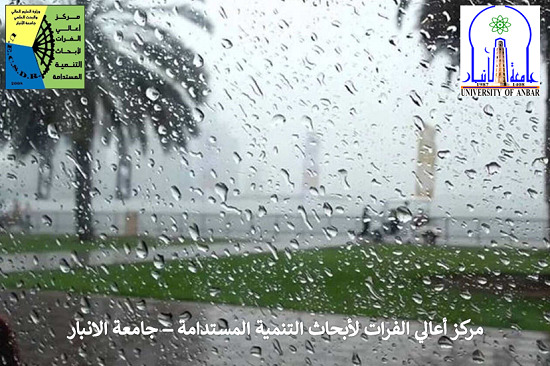| News Details |
Rain statistics and monitoring of climate change during the first quarter of the 2024-2025 seasons
2025-02-08

The Planning and Databases Department at the Upper Euphrates Center for Sustainable Development Research issued rainfall statistics for the month of October, December and January for Ramadi, Rutba and Haditha stations with an analysis of rain and comparing it with the available data for previous years to determine the extent of climate change and its impact on rainfall as follows:
Ramadi station: By observing the data recorded for the Ramadi station in November of this year, a quantity of rain was recorded of 38.2 mm, compared to 132.6 mm in 1926, 68.1 mm in 1977, 51 mm in 1968 and 50 mm in 2023, and according to the data available from 1923 until now, it indicates that the dry period (rain less than 10 mm) for this month can last from 4 to 5 years, especially after 2000. This indicates a significant extremity between the amounts of rain recorded from year to year. Overall, this amount is relatively good compared to the impact of climate change after 2000.
As for the amount of rainfall recorded in December of the year, it was recorded 1.4 mm compared to 53.1 mm recorded in 1997, 49.8 mm in 1935 and 44.3 mm in 1988, and after reviewing the available data from 1923 until now, it was found that the dry years can continue for every 4 years. In general, the idea of rainfall in December 2024 is very low and may indicate the impact of climate change, but the dry cycle is within its normal rates in light of the recorded data. Comparing the rainfall for the month of January, the amount of rain was recorded 9 mm compared to the highest amount of rain recorded 54.5 mm in 1933, 41.5 mm in 1934, 76.4 mm in 1973 and 52 mm in 2006. Therefore, the dry period for this month indicates that it lasts up to one year until 2008 compared to recent years.
Rutba Station:
By observing the data recorded for the Rutba station in November of this year, a rainfall amount of 5 mm was recorded compared to 100.3 mm in 1994, 57.8 mm in 1998 and 46.4 mm in 1972, and according to the data available from 1960 until now, it indicates that the dry period (rain less than 10 mm) for this month can last for 4 consecutive years. Comparing the rainfall for the month of January (for winter rains), the amount of rain was recorded 8 mm this year, and compared to the highest amount of rain recorded for previous years, 46.4 mm was recorded for the same month 2001, 37.2 for 1988 and 56.6 for 1965, and therefore the dry period for this month indicates that it lasts 3 years maximum, which gives an indication that autumn rains are at greater rates, but the amount of rain in winter is less.
Haditha station:
By observing the data recorded for a modern station in November of this year, a rainfall amount of 5 mm was recorded compared to 50.5 mm in 1967, 32.2 mm in 1980, 37.2 mm in 1989, 140 mm in 1994 and 95.1 mm for 1997, and according to the available data from 1923 until now, it indicates that the dry period (rain less than 10 mm) for this month can last from 3 to 4 years, especially after the year 2000, which indicates a significant extremity between the amount of rainfall recorded from year to year.
As for the amount of rain recorded in December of this year, 4.8 mm was recorded, compared to 53.1 mm recorded in 1935, 44.3 mm in 1988 and 49.8 mm in 1935, and after reviewing the available data from 1923 until now, it was found that the dry years for this month can continue for every 4 years.
#Upper_Euphrates_Center_for_Sustainable_Development_Research






